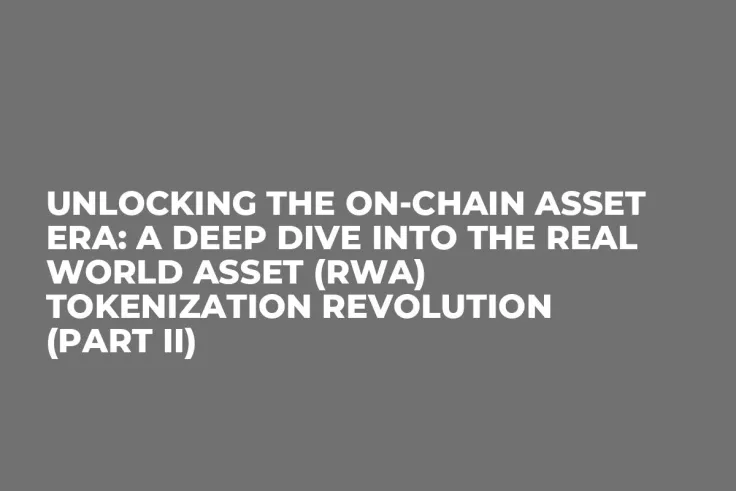
Disclaimer: The opinions expressed by our writers are their own and do not represent the views of U.Today. The financial and market information provided on U.Today is intended for informational purposes only. U.Today is not liable for any financial losses incurred while trading cryptocurrencies. Conduct your own research by contacting financial experts before making any investment decisions. We believe that all content is accurate as of the date of publication, but certain offers mentioned may no longer be available.
- Tokenized U.S. Treasuries: The Institutional Entry Point into Onchain Finance
- Key Players and Product Design Archetypes
- Tokenized Private Credit: High-Yield, High-Risk Corner of the RWA Market
- Platform Landscape and Lending Models
- Public Equities Onchain: Europe Leads as Tokenized Stocks Gain Institutional Shape
- Tokenized European Sovereign Bonds: Regulated Rails for Public Debt
- Representative Project: Spiko AMF Bond Tokens
- Tokenized Commodities: Gold-Backed Assets for DeFi Collateral
- Conclusion: RWAs as the Foundation of the Next Financial Epoch
- About CoinEx
With tokenization rails now in place, attention is turning toward what assets actually flow through them. RWAs are not created equal—while Treasuries deliver safe, regulated returns, private credit offers yield with elevated risk; tokenized equities walk a tightrope between compliance and composability.
This Part 2 report from CoinEx Research examines five major RWA asset categories currently gaining traction on-chain:
- U.S. Treasuries as the benchmark institutional product
- Private Credit as a high-yield, structurally diverse segment
- Tokenized Equities as an emerging DeFi-accessible instrument
- Sovereign Bonds as a regulated public debt experiment
- Commodities as DeFi-native, real-world collateral
Each category reflects different combinations of yield, composability, and compliance—and together, they form the real battlefield for RWA adoption in 2025 and beyond.
Tokenized U.S. Treasuries: The Institutional Entry Point into Onchain Finance
Tokenized U.S. Treasuries represent the most mature and institution-ready segment of the RWA market. They deliver risk-free yield, on-chain liquidity, and programmable compliance—all in one product.
Long regarded as the global benchmark for “risk-free” return, U.S. Treasuries are now being reimagined on-chain as foundational assets for institutional DeFi. This segment has grown over 9x YoY, led by regulated issuers leveraging Ethereum and other L1s to deploy fully compliant, yield-bearing tokens.
Key Players and Product Design Archetypes
Among current offerings, three leading products illustrate two main design philosophies:
- Compliance-First & Stable
Tokens like BUIDL and BENJI are designed for institutions requiring strong custody, audit trails, and restricted secondary transfers. These tokens embed traditional fund logic and are suitable for regulated portfolios.
- Liquidity-Friendly & Flexible
USDY adopts a more DeFi-native approach: it’s accessible to non-U.S. users, composable within smart contracts, and usable across protocols—making it attractive to Asia and Middle East markets.
Notably, 93% of BUIDL’s supply is on Ethereum, reinforcing its role as the institutional base layer for on-chain finance.
CoinEx Research expects that as regulatory clarity improves—via frameworks like MiCA and the GENIUS Act—and infrastructure (custody, issuance, KYC) becomes standardized, tokenized Treasuries are well-positioned to become the benchmark asset for institutional blockchain allocation.They are likely to be the first RWA category to scale after stablecoins, paving the way for broader institutional participation in tokenized credit, real estate, and equities.
Tokenized Private Credit: High-Yield, High-Risk Corner of the RWA Market
Following the rise of tokenized U.S. Treasuries as the risk-free benchmark for on-chain yield, the market is now moving further along the risk curve. Next in line: tokenized private credit—high-yield, high-risk, and structurally diverse.
Tokenized private credit segment stands out as the most yield-attractive yet structurally fragmented RWA segment—offering >10% APR but operating at the edge of regulatory clarity. As of mid-2025, active loan volume hit $14.16B, with Figure and Tradable contributing ~95%.Institutional issuers are scaling rapidly, while DAO-native models continue to evolve.
Platform Landscape and Lending Models
These platforms span a spectrum—from institutional-grade frameworks (Figure, Tradable) to DeFi-native experiments (Maple, Goldfinch). Centrifuge explores innovative use of NFTs for SME receivables.
CoinEx Research views tokenized private credit is maturing into a mid-risk, yield-bearing primitive:
- Figure & Tradable: Will likely anchor institutional adoption via scale and regulatory strength
- Maple & Goldfinch: Serve crypto-native demand, but must enhance underwriting and risk controls
- Centrifuge: A promising model for SME lending if transparency and compliance hold
Public Equities Onchain: Europe Leads as Tokenized Stocks Gain Institutional Shape
While private credit stretches the risk spectrum, another frontier is gaining traction: tokenized public equities. Though early in development, this segment reflects growing ambition to bring all financial instruments—debt and equity—onto the blockchain.
Tokenized equities have yet to rival traditional stock markets—but a cross-border “tokenized equity corridor” is emerging, led by Europe and select regulatory environments focused on non-U.S. accredited investors.
Backed Finance: DeFi-Integrated Tokenized Equities
Among current platforms, Backed Finance leads with the most DeFi-compatible model. Under Switzerland’s DLT Act, Backed offers ERC-20 tokenized shares and ETFs (e.g., Tesla, NVIDIA, S&P 500) .This positions Backed as the only tokenized equity issuer natively embedded in the DeFi stack.
Alternative Models: Walled Gardens and Compliance Channels
Other platforms like Securitize (U.S.-based) and Archax (UK FCA-regulated) offer tokenized stocks within highly permissioned, institutional environments—often requiring broker-dealer custody and limiting peer-to-peer transferability.
CoinEx Research believes that tokenized equities are transitioning from regulatory pilots to early-stage real-world deployment, shaped by:
- Geographic bias: Europe leads, leveraging lighter sandbox frameworks
- Investor segmentation: Focus on institutional or accredited participants
- Strategic divergence: DeFi liquidity vs. compliance-first pathways
We see Backed Finance as defining the path for DeFi-native tokenized equities, while platforms like Securitize and Archax enable cautious entry points for traditional issuers seeking blockchain exposure.
Tokenized European Sovereign Bonds: Regulated Rails for Public Debt
As tokenized equities challenge traditional equity markets, the public sector is also moving—albeit more cautiously—toward tokenization. Sovereign bonds are now entering the chain via fully regulated rails in Europe and Asia.
Unlike U.S. Treasuries, which are often tokenized by private issuers, European sovereign bonds are directly tied to regulatory pilots and public-sector initiatives. This top-down approach serves as a proving ground for institutional-grade digital debt infrastructure.
As of June 2025, total TVL in tokenized sovereign bonds remains modest at ~$237M, but the growth rate has picked up, especially in regulated environments like France and Hong Kong.
Representative Project: Spiko AMF Bond Tokens
- EUTBL (Euro bond) and USTBL (USD bond), issued under French AMF registration
- Fully UCITS-compliant, redeemable, and self-custodied
- Deployed on Ethereum and Arbitrum
- Designed to meet traditional portfolio mandates while integrating onchain rails
Tokenized sovereign debt is emerging as a strategic entry point for regulated RWAs, particularly in non-U.S. markets where regulatory support enables innovation. CoinEx research anticipates:
- Europe and Asia will lead adoption, thanks to regulatory sandboxes and central bank pilots
- Liquidity and composability remain limited, but tokenized bonds offer a low-volatility anchor for institutional portfolios
- As custody standards, programmable coupon systems, and cross-border issuance improve, this segment will gradually scale as a compliant RWA rail
Tokenized Commodities: Gold-Backed Assets for DeFi Collateral
Beyond sovereign debt, hard assets like gold are also finding utility on-chain. Tokenized commodities are increasingly used as collateral in DeFi and offer a bridge between stable value and blockchain composability.
Tokenized commodities—especially gold—offer real-world price exposure with blockchain-native features such as 24/7 trading and composability. Current players include Tether Gold and Pax Gold. This asset class sits at the intersection of stability and liquidity, often serving as a DeFi-native collateral asset.
Regulatory classification (commodity vs. security), price oracle reliability, and physical custody standards remain key barriers to broader adoption.
CoinEx Research sees tokenized commodities as a bridge between traditional hard assets and programmable finance—well-suited for investors seeking composable, low-volatility exposure in multi-asset portfolios.
Conclusion: RWAs as the Foundation of the Next Financial Epoch
With tokenization rails firmly in place, Part II of our RWA report turns its lens toward the assets flowing through them.
We believe U.S. Treasuries have become the institutional on-chain benchmark—combining regulatory certainty, DeFi integration, and high trust custody. Private credit is emerging as a high-yield, high-risk frontier, still fragmented in structure and oversight. Tokenized equities, while nascent, signal the industry's ambition to bring public equity on-chain—led by European DeFi-integrated models like Backed. Meanwhile, sovereign bonds and gold-backed commodities are establishing low-volatility, compliant rails for institutional portfolios.
These five asset classes reflect the real-world diversity and design trade-offs of the tokenization revolution: from composability vs. compliance, to yield vs. security.
Looking ahead, we believe:
- Tokenized Treasuries and private credit will anchor the first wave of institutional allocation;
- DeFi-native equity models will co-exist with permissioned issuance;
- Sovereign and commodity-backed RWAs will serve as regulated, capital-efficient instruments.
The on-chain capital market is no longer hypothetical—RWAs are moving from experimentation to execution.
About CoinEx
Established in 2017, CoinEx is an award-winning cryptocurrency exchange designed with users in mind. Since its launch by the industry-leading mining pool ViaBTC, the platform has been one of the earliest crypto exchanges to release proof-of-reserves to protect 100% of user assets. CoinEx provides over 1400 coins, supported by professional-grade features and services, for its 10+ million users across 200+ countries and regions. CoinEx is also home to its native token, CET, incentivizing user activities while empowering its ecosystem.
To learn more about CoinEx, visit: Website | Twitter | Telegram | LinkedIn | Facebook | Instagram | YouTube
 Gamza Khanzadaev
Gamza Khanzadaev Vladislav Sopov
Vladislav Sopov Godfrey Benjamin
Godfrey Benjamin Arman Shirinyan
Arman Shirinyan